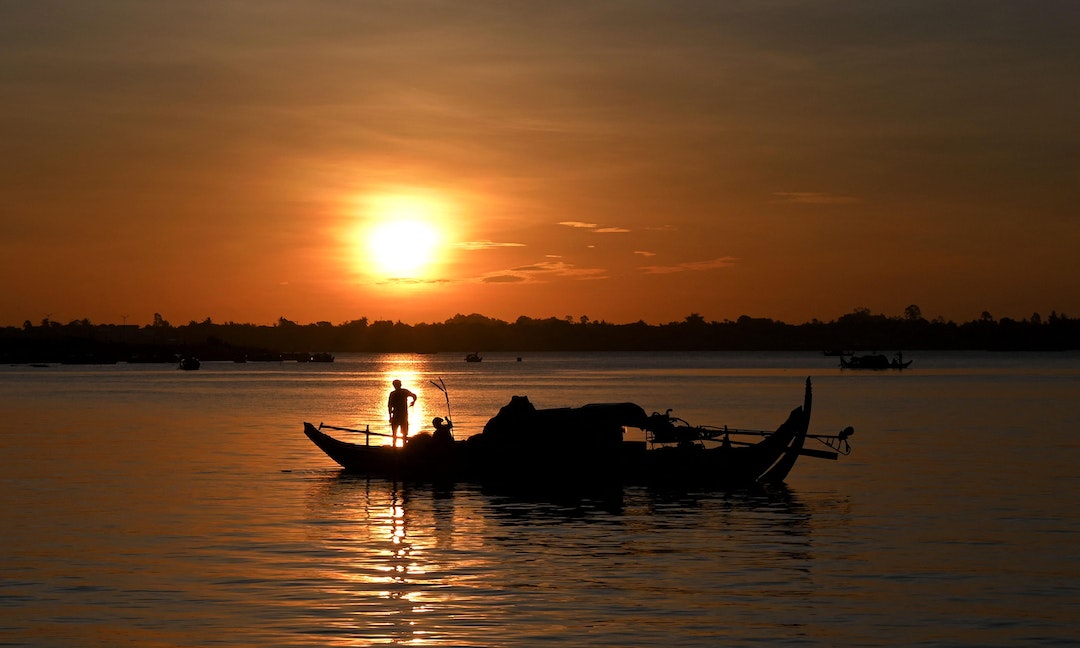
PHNOM PENH, CAMBODIA — Heavy rains and a bumper fish crop have improved life along the Mekong River after a nearly four-year drought, poor harvests, and the pandemic took a heavy toll on some 65 million people who rely on the waterway for their daily livelihoods.
According to the Laos-based multinational Mekong River Commission, which coordinates use of Mekong resources, the drought had affected fish and agricultural production but ended as mainland Southeast Asia experienced regular rainfall last year and late rains that extended the wet season into December.
The Lower Mekong Basin, including Thailand, southern Laos, Cambodia, and Vietnam, fared best, and a commission spokesperson said “the region is not still in a drought.”
Meteorologically, he said, the basin “has been in normal and wet conditions since January.”
A return to “normal” had Cambodia’s Agriculture, Forestry and Fisheries Ministry forecasting a much improved 2022-23, as the annual fishing season got under way with families fermenting carp into the traditional prahok, or fish sauce.
It said initial reports suggest this year’s harvest is up by as much as 40% over last year as fish begin migrating from the Tonle Sap Lake in central-west Cambodia, navigating streams and creeks and into the Mekong and Bassac rivers.
A targeted moratorium on catching endangered species during spawning season and the “effective prevention of illegal fishing activities in the Tonle Sap Lake” had produced an “increased number of wild freshwater fish” during the 2022 breeding season, the ministry said.
However, analysts said the improved outlook remained patchy and that it was too early to say the drought was over, while many fishers say that although bumper catches were helped by illegal electric nets, the harvest was still low because of dams.

Taing Makara, a fisherman speaking from his boat on the shoreline of the Mekong east of Phnom Penh, agreed, saying his fish catches along the Mekong and its tributary, the Tonle Sap, were down about 50% compared to five to 10 years ago.
“During these last few years, after the dams were built, I could barely catch a fish – when I went fishing – it’s hard to make a livelihood and I lost money because I fished every day and some days I made money and some I days not catch any fish at all,” he told VOA.
Water levels have returned to the low level normal for this time of year with the dry season nearing its peak, but Brian Eyler, director of the Southeast Asia Program at the Stimson Center in Washington, said drought recovery has been limited.
“The flood of the 2022 wet season was still extremely dry in northern Thailand, in the Golden Triangle and all points upward in southwest China. Yet we still saw robust Tonle Sap expansion due to so much water falling over the Tonle Sap part of Cambodia,” he told VOA.
“So watch the next few wet seasons to determine whether the drought’s passed,” he said, adding climate change and further dam construction in Laos had changed the outlook.
“The new normal is abnormality and climate change is going to deliver a lot of curveballs to the Mekong, like more intense storms, prolonged drought periods, shorter wet seasons and the shifting peak of the Tonle Sap expansion,” he said.
According to the Stimson Center, which tracks the Mekong, a cascade of more than 400 dams, big and small, have been built, are under construction, or are on the drawing board as part of a rapid modernization drive in China and mainland Southeast Asia.
Many of the dams are in Laos, which intends to improve living standards by becoming the “battery of Southeast Asia” — selling hydroelectricity across the region through Thailand, to provide reliable energy for industry, flood control, irrigation for farmers, and clean drinking water.
But the primary concerns are 11 dams that block the mainstream of the river.
Three more mainstream dams are planned, including one at Luang Prabang in Laos, near a World Heritage Site, and in a known earthquake zone.
Another, the Sekong A dam, will cut off the last and longest undammed tributary of the Mekong close to the southern floodplain. The Sekong tributary contributes 10% of the water flowing in the Mekong River.
Laos and China have said fish ladders constructed within the dams have mitigated any impact on fish migration and numbers and ensured a steady flow of water during drought.
Chiang Mai, Thailand-based filmmaker Tom Fawthrop produced A River Screams for Mercy: Murdering the Mekong, a documentary about activists who are demanding a dam construction moratorium.
“There was a scientific report that warned everybody what the impacts would be,” he told VOA. “Now when we look at the Mekong today, the dams like the Xayaburi Dam; farmers and fishermen and communities are complaining most of the fish catch has been destroyed.”
Vietnam’s Center for Earthquake and Tsunami Warnings said in 2011 that the Xayaburi Dam in northern Laos might increase the probability of earthquakes, given the weight of the dam and the pressure it creates on subsurface fault lines, in a region already prone to seismic activity.
Chulalongkorn University in Bangkok has said there remains a 30% chance a medium-sized earthquake will hit the dam within 30 years, and a 10% chance of a magnitude 7.
“Not sufficient attention has been given to the earthquake threat around northern Laos. All these new dams are being built in a very earthquake-active zone,” Fawthrop added.
He said these issues should be dealt with when prime ministers from Cambodia, Laos, Thailand, and Vietnam “deliberate the fate of the Mekong River Basin” at their fourth Mekong River Commission summit in April.
The News Lens has been authorized to publish this article from Voice of America.
READ NEXT: Paraguay President to Visit Taiwan Ahead of Elections
TNL Editor: Bryan Chou (@thenewslensintl)
If you enjoyed this article and want to receive more story updates in your news feed, please be sure to follow our Facebook.







